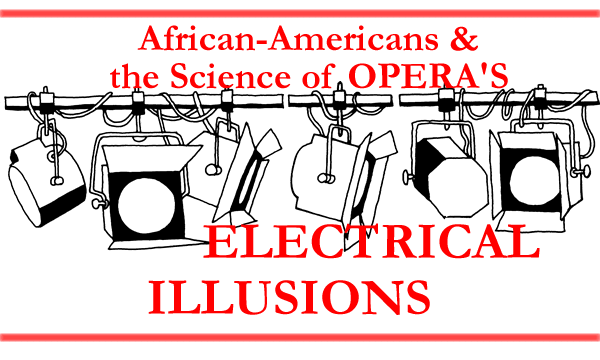
What we "see" in The Elixir of Love is just as important as what we hear. The visual layout of an opera production allows us to visually experience the opera just as the music allows us to aurally experience it. Through costume, set, and lighting, the illusion of another time and place is created on the stage. The lighting specifically allows the entire scene to be given mood and depth. This enables the designer to use light to create feeling and movement that accompanies the sound of the music.
The contributions of two famous African-American scientists, Lewis Howard Latimer and Granville T. Woods have made the brilliance of electrical lighting possible. Lewis Latimer, born the son of a former slave, quickly started his service to the nation by joining the Navy at age sixteen during the Civil War. His interest in drawing and mechanics got him his first position with the patent soliciting company of Crosby and Gould in 1865, and in a few years he was chief draftsman. In 1876, Latimer was given the job of drawing the blueprints for Alexander Graham Bell's recently invented telephone. He was well on his way toward a prosperous career in mechanical engineering.
In 1879, Latimer became head of the U.S. Electric Lighting Company in Bridgeport, Connecticut and began his real interest in future electricity. By 1882, he received a patent for the manufacturing process of carbon filaments in light bulbs. This giant advancement in electrical lighting improved the duration and conductibility of the filament itself. In 1884, Latimer became the only Black member of the Edison Pioneers, the specialized scientific team who worked for the Edison Pioneers company. Here, he helped bring Thomas Edison's electrical lighting system to Canada and the cities of New York, Philadelphia and London. By this point, Latimer had also become an accomplished writer and civil rights activist and continued his great contribution to the nation.
Granville T. Woods also started his career early by becoming a fireman-engineer for the railroads in Missouri at age sixteen. Several jobs later, Woods was able, through pursuit of mechanical and electrical engineering, to open a factory in Cincinnati, Ohio in 1881. Specializing in the manufacturing of telephone and telegraph equipment, Woods invented a more powerful telephone and transmitter and by 1885 had sold his "telegraphony" apparatus to American Bell. By combining the transmissions of signal and oral messages through the line, with telegraphony, the complexity of Morse code was greatly reduced. Woods continued his inventive streak and in 1887 patented a communication system between moving trains and railway stations which increased the safety and efficiency of railway travel.
In 1890 at a theatre in New York, Woods became interested in the dimming apparatus utilized by the electrical lighting system in the performing arts community. His next project improved the dimming system by decreasing its energy output and the threat of electrical fires common at the time. Woods became a giant in the electrical and mechanical world accumulating over one-hundred and fifty patents from the electrified "third rail" configuration that powers the New York and Chicago subway to an electrical incubator by his death in 1910.
Both Lewis Latimer and Granville Woods played a great part in creating the modern electrical world as we know it today. They exemplify the industriousness of the Industrial Revolution itself and the commitment toward the pursuit of science. It is this pursuit which has given our theaters light, our productions depth, and our operas their "electrical" illusions.
Used by kind permission of the Opera Company of Philadelphia's Sounds of Learning Program.
The Composer | Donizetti's World | Geology | Timeline | The Story | Censorship
Elixir of Love Home Page